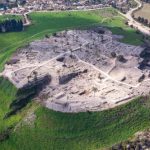 Weird Stuff
Weird Stuff  Weird Stuff
Weird Stuff  Our World
Our World 10 Ways Your Christmas Tree Is More Lit Than You Think
 Movies and TV
Movies and TV The 10 Coolest Stars to Set Sail on The Love Boat
 History
History 10 Things You Didn’t Know About the American National Anthem
 Technology
Technology Top 10 Everyday Tech Buzzwords That Hide a Darker Past
 Humans
Humans 10 Everyday Human Behaviors That Are Actually Survival Instincts
 Animals
Animals 10 Animals That Humiliated and Harmed Historical Leaders
 History
History 10 Most Influential Protests in Modern History
 Creepy
Creepy 10 More Representations of Death from Myth, Legend, and Folktale
 Technology
Technology 10 Scientific Breakthroughs of 2025 That’ll Change Everything
 Weird Stuff
Weird Stuff Ten Bizarre Facts About The Doge Meme
 Our World
Our World 10 Ways Your Christmas Tree Is More Lit Than You Think
 Movies and TV
Movies and TV The 10 Coolest Stars to Set Sail on The Love Boat
Who's Behind Listverse?

Jamie Frater
Head Editor
Jamie founded Listverse due to an insatiable desire to share fascinating, obscure, and bizarre facts. He has been a guest speaker on numerous national radio and television stations and is a five time published author.
More About Us History
History 10 Things You Didn’t Know About the American National Anthem
 Technology
Technology Top 10 Everyday Tech Buzzwords That Hide a Darker Past
 Humans
Humans 10 Everyday Human Behaviors That Are Actually Survival Instincts
 Animals
Animals 10 Animals That Humiliated and Harmed Historical Leaders
 History
History 10 Most Influential Protests in Modern History
 Creepy
Creepy 10 More Representations of Death from Myth, Legend, and Folktale
 Technology
Technology 10 Scientific Breakthroughs of 2025 That’ll Change Everything
10 Historical Discoveries We Weren’t Expecting in 2025
We are just over eight months into the new year, and already, several significant historical discoveries have been announced. These discoveries span continents and thousands of years of history, and as we learn more about them, they continue to expand our knowledge of those who came before us. Among these are discoveries that we weren’t necessarily expecting, and these have changed how historians view past events.
On this list are just ten of these unexpected historical findings, and there is no doubt that there are many more to come.
Related: 10 WWII Discoveries Kept Secret or Hidden for Decades
10 Physical Evidence of Gladiators Fighting Wild Animals
A skeleton of a young man, buried between 1,725 and 1,825 years ago in what is now York, England, has been recovered from a Roman cemetery. While the skeleton itself is nothing out of the ordinary, the bite marks on its pelvis instantly intrigued historians and archaeologists.
The remains were recovered from Driffield Terrace, which is believed to be a gladiator graveyard. The bite marks were made by a large cat, most likely a lion. Experts believe they are the first physical evidence of the Romans’ documented fights between gladiators and animals.
The marks also suggest that gladiators are buried at the cemetery, not slaves or soldiers, as once thought. In-depth analysis of the skeleton revealed that the man, aged between 26 and 35, suffered malnutrition as a child. There was also evidence of spine issues and lung inflammation. The analysis also showed that the lion bite never healed and caused the man’s death. He was decapitated after he died—possibly as a mercy killing.[1]
9 3,000-Year-Old Lost Mayan City
Archaeologists working in Guatemala’s northern jungle unearthed the ruins of a 3,000-year-old Mayan city earlier this year. The remains include monuments and pyramids, suggesting the site was once integral to ceremonial rites.
Experts date the remains to the Middle Preclassic period, from approximately 800 to 500 BC. Nicknamed Los Abuelos, after the sculptures of an “ancestral couple” found at the site, the area covers around 6 square miles.
Among the ruins is a 33-foot-high (10-meter-high) pyramid with an intricate canal system and murals dating to the Preclassic period. Archaeologists confirmed that Los Abuelos once stood 13 miles (21 km) from Uaxactun, another important historical site in the Petén department.[2]
8 2,300-Year-Old Celtic Sword
Excavations at a burial site in France have unearthed two Celtic swords dating to the Second Iron Age. Both swords were still inside their scabbards, which helped protect them from the elements. One of the scabbards is adorned with ornate, polished gems—and two of these gems have swastika markings on them.
Ancient swastikas are not related to anything Nazi. Instead, they were common symbols in the Mediterranean and among the Celts during the late fifth to fourth century BC.
There are no skeletons in the burial site where the swords were found, due to the high levels of acidity in the soil. However, other metal artifacts were also discovered, including decorated fibulae and copper alloy bracelets.[3]
7 Intact Roman-Era Shipwreck
Türkiye’ s Culture and Tourism Minister Mehmet Nuri Ersoy dived down into the depths of the ocean off Adrasan to personally inspect a recently discovered 2,000-year-old intact Roman-era shipwreck. The wreck lies 150 feet (46 m) below the sea surface and still contains its original cargo of ceramic plates, pots, trays, and bowls.
These ceramics were once coated in raw clay, which allowed their colors and designs to stay protected underwater. They still lie perfectly stacked in the position they were packed in, providing a stunning historical snapshot.
Archaeologists agree that the ship was transporting consumer goods when it sank and noted that it is one of more than 400 discovered in the region over the years. The latest discovery again highlights the area’s significance in maritime trade and commerce.[4]
6 Possible Location of Mahanaim
In January 2025, researchers announced the discovery of a 2,700-year-old archaeological site in Jordan. They also suggested that a residence on the site may have been used by the kings of Israel, possibly including King David.
The site itself is thought to be that of the biblical city of Mahanaim, which was part of the kingdom of Israel. Mahanaim in ancient Hebrew means “two camps.” According to biblical passages, it was located beside Penuel. Researchers believe that an archaeological site called Tall adh-Dhahab esh-Sharqi is Penuel. It lies near the newly discovered site of Mahanaim, also known as Tall adh-Dhahab al-Gharbi.
The Bible also speaks of a temple in Penuel, and remains of what may have been a temple have been uncovered at Tall adh-Dhahab esh-Sharqi.[5]
5 Drag Marks Left by Ancient Vehicles
Researchers have found drag marks alongside 20,000-year-old footprints at White Sands National Park in New Mexico. After consulting with Indigenous communities, they concluded that a type of travois left the marks. These wooden vehicles—essentially wheelbarrows without wheels—would have allowed humans to transport goods by dragging them across the ground.
It is believed that dogs pulled these travois, and later, horses, during the time European colonizers entered the region. Some researchers, however, think only humans pulled the travois in New Mexico, since no animal evidence has been found near the drag marks here. The size of the footprints suggests that adults would have pulled the travois, while children followed.
This discovery proves our ancestors had some form of “transport” that allowed them to migrate long before the invention of wheels. Some of the travois tracks measure up to 165 feet (50 m) at several points throughout the park.[6]
4 Evidence of Humans on Malta
The discovery of food waste, stone tools, and hearths at a cave site in Latnija has overturned researchers’ long-held beliefs about when humans first settled on Malta. This new evidence suggests they traveled from mainland Europe to the island 1,000 years earlier than previously believed.
Researchers now think these humans were not farmers, but hunter-gatherers instead. This discovery also challenges the consensus within the scientific community that hunter-gatherers were unable to travel to remote islands. Scientists now say that history textbooks and museum exhibits may need to be updated to reflect the findings.
These results are the culmination of six years of excavations, testing, and research conducted in Malta and other locations.[7]
3 Second Hidden City Found Below Giza Pyramids
The announced discovery of a “second hidden underground city” beneath the Giza pyramids has sparked a heated debate. A team of Italian researchers claims to have found an underground network that includes staircases, water pipelines, and vertical shafts. They also believe that the legendary Hall of Records, an ancient Egyptian library mentioned in lore, may be part of this underground city.
Many Egyptian archaeologists have strongly disputed these claims, particularly the assertion that the subterranean complex links the pyramid of Khafre to the Khufu and Menkaure pyramids and the Great Sphinx. Filippo Biondi, a radar expert from Scotland, insists that radar images show a 90 percent probability that the Khafre and Menkaure pyramids share the same underground pillars.
The Italian researchers also proposed the controversial theory that the Giza pyramid complex was built 38,000 years ago, not 4,500 years ago, as generally accepted. It should be noted that these findings have not yet been published in a peer-reviewed scientific journal and remain highly disputed.[8]
2 Void Found at “Noah’s Ark” Site
The discovery of a tunnel-like void running through the “Noah’s Ark” structure at the Durupinar site in Türkiye has once again ignited heated debate.
Most scientists maintain that the Durupinar site is a natural rock formation. However, a team of American researchers argues that ground-penetrating radar and electrical resistivity tomography scans reveal structural patterns inconsistent with natural rock. The scans also detected a tunnel-like void stretching through the center of the formation and three distinct layers. According to the team, these layers match the Bible’s description of the Ark’s three decks.
The researchers also note that the formation’s size aligns with the biblical measurement of 300 royal Egyptian cubits and that soil tests revealed organic matter that could indicate decomposed wood. Still, most archaeologists remain unconvinced, and further research is needed. Core drilling is planned for 2026 to determine whether the formation is artificial or natural.[9]
1 Newly Discovered Ruins Linked to Ark of the Covenant
A team of archaeologists conducting excavations at the city of Shiloh has discovered the ruins of a stone structure they believe matches the layout and dimensions of the biblical Tabernacle. According to the Bible, the Tabernacle once housed the Ark of the Covenant, a gold-covered chest in which the Ten Commandments tablets were placed.
Around these ruins, the team found over 100,000 animal bones, mainly from goats, cattle, and sheep. The team suggests that this is evidence of ritual sacrifices, which aligns with biblical accounts.
There is also evidence that pottery from the site dates back to the period when the Tabernacle was used, nearly 400 years before the Jerusalem Temple was built. However, while the discovery may shed light on the Tabernacle, it does not bring us closer to finding the actual Ark of the Covenant. The Israelites are believed to have built the Ark around the 13th century BC, and it remains one of the most sought-after artifacts in biblical archaeology.[10]








